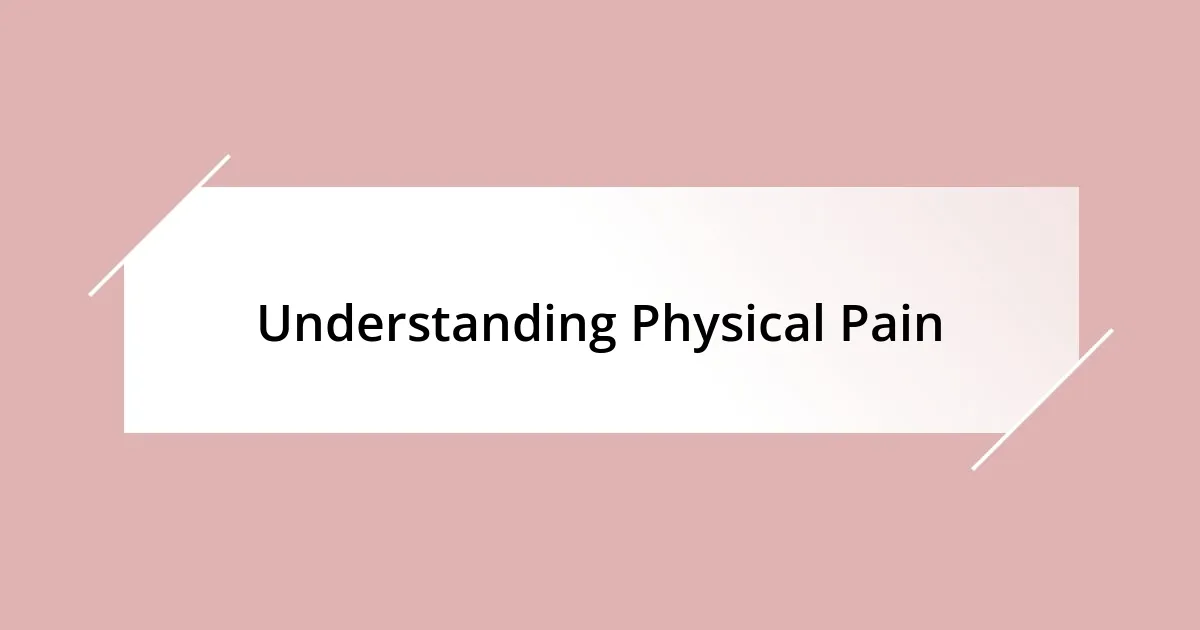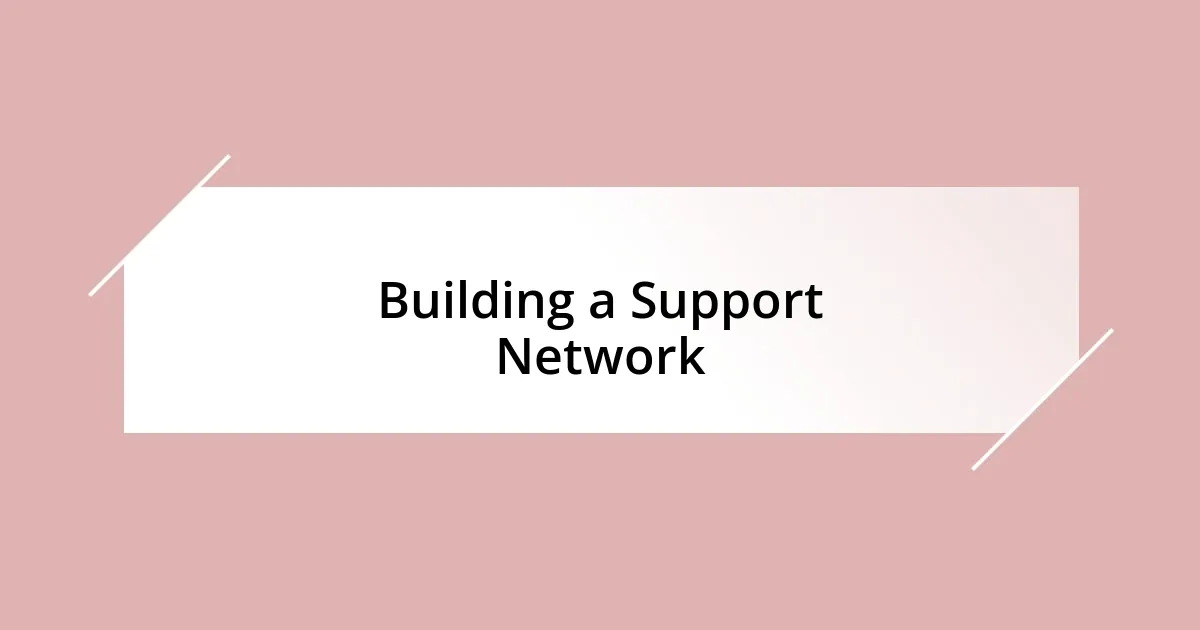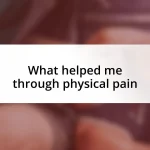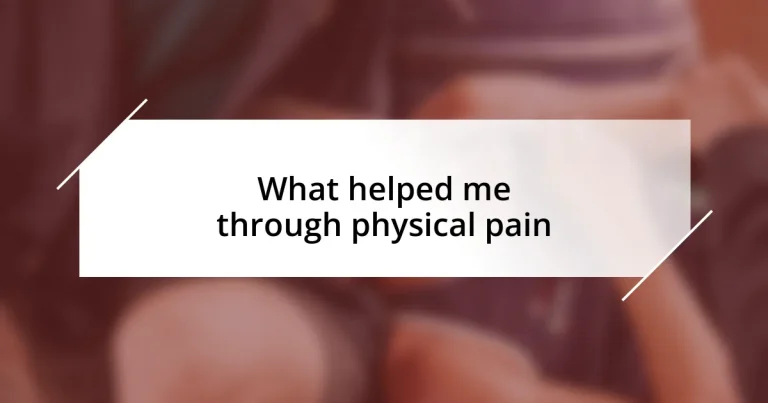Key takeaways:
- Physical pain is intertwined with emotional well-being; acknowledging both aspects is crucial for effective healing.
- Identifying personal triggers, such as stress or environmental factors, can enhance pain management strategies.
- Practical techniques like mindfulness, breathing exercises, and gentle movement can significantly alleviate pain.
- Building a support network and seeking professional help are key components in navigating chronic pain effectively.

Understanding Physical Pain
Physical pain is something that most of us have experienced at some point, but its complexity often goes unnoticed. I remember a lingering backache that made even the simplest tasks feel monumental. Why does this discomfort linger in our bodies, almost as if it has its own story to tell? It’s fascinating how pain can create an emotional ripple effect, influencing not just our physical state but also our mood and mental health.
Understanding pain goes beyond just the physical sensation; it intertwines with our psyche. There was a time when I felt overwhelmed by chronic pain, and I realized that acknowledging my emotional response was just as important as seeking physical relief. Why do we sometimes feel guilt or frustration alongside our pain? This blend of emotions can complicate our healing process, making it crucial to address both our physical and emotional well-being.
Moreover, pain isn’t merely a villain in our lives; it can also serve as a teacher. During moments of intense discomfort, I often found myself reflecting on what my body was trying to communicate. Have you ever paused to consider the lessons pain can impart? Embracing this perspective might just help us navigate our relationships with pain, turning it into an opportunity for growth rather than just a source of suffering.

Identifying Personal Triggers
Identifying personal triggers often feels like piecing together a complex puzzle. For instance, I observed that stress plays a significant role in my physical pain. When I encountered tight deadlines at work, my back pain would spike, prompting me to realize that my emotional state directly influences my discomfort. Have you noticed similar patterns in your own life?
Understanding what triggers discomfort can lead to effective pain management strategies. I recall an episode after a long family gathering where my neck stiffness flared up. Reflecting on that, I recognized that prolonged social interactions could be draining for me. This insight urged me to set healthier boundaries in social situations, ultimately helping mitigate my pain.
When I began journaling about my pain experiences, I discovered specific environmental triggers. Sometimes, the weather alone would affect my body, especially during humid days. I found that keeping track of these triggers not only empowered me but also educated me on how to prevent pain flares. Have you ever tried documenting your triggers? It can be a game changer.
| Trigger Type | Example Experience |
|---|---|
| Emotional | Stress from work impacting back pain |
| Environmental | Humidity leading to increased discomfort |
| Social | Prolonged interactions causing neck stiffness |

Practical Pain Management Techniques
When it comes to managing pain, I’ve found that practical techniques can make a remarkable difference. For instance, deep breathing exercises have consistently helped me regain a sense of control during flare-ups. I remember sitting on my couch, feeling the tension in my shoulders. As I focused on my breath, inhaling slowly through my nose and exhaling deeply through my mouth, I could almost feel the tightness melting away. Not only did it distract my mind, but it also physiologically calmed me down, providing relief.
- Mindfulness Meditation: This technique encourages present-moment awareness, helping me let go of stress-induced pain.
- Physical Activity: Gentle movement, like stretching or yoga, proved invaluable in easing my discomfort; I learned to listen to my body.
- Heat Therapy: Using a heating pad relieved muscle tension for me, especially after long hours on my feet.
- Cold Compresses: Applying these after intense pain flares reduced swelling, making a noticeable difference in my recovery time.
In my experience, combining these techniques has been incredibly effective. I usually keep a journal to track what works for me. One evening, after an exhausting day, I noticed that alternating between heat and cold treatments significantly helped my lower back pain. It’s fascinating; by reflecting on my experiences, I discovered patterns that allowed me to be proactive in my pain management approach. Have you considered this tracking method? It could uncover surprising insights that facilitate better pain relief.

Mindfulness and Pain Reduction
I often find myself in a whirlwind of thoughts when facing physical pain, but practicing mindfulness can create a small oasis of calm amidst the chaos. I remember a particularly rough day when my joints ached after a long hike. Instead of wallowing in discomfort, I took a moment to ground myself. By focusing solely on my breath, I traced the sensations in my body, acknowledging the pain without judgment. This practice shifted my perspective in such a profound way — it felt less like an enemy and more like an experience to observe.
Engaging in mindfulness meditation has been my secret weapon for pain reduction. One night, while feeling particularly stiff from a long week, I carved out time to sit and meditate. I visualized my breath flowing through the areas where I felt tension, and as I did, I noticed something remarkable. I no longer fought against the pain; I welcomed it as part of living in my body. Have you ever tried this approach? For me, it built a bridge between my mind and body, leading to not only physical relief but emotional resilience as well.
When I’m confronted with pain, I often ask myself how to be more present, and incorporating mindfulness has helped me answer that. After an overwhelming day filled with errands, I found myself curled up on the couch, unable to move. Instead of spiraling into frustration, I practiced a simple guided meditation. I noticed how my mind danced around my discomfort, and with gentle awareness, I learned to listen to my body instead of resisting it. That moment of connection transformed my experience, showing me how powerful being present in the moment can be when navigating pain. What about you? How might mindfulness shift your relationship with discomfort?

Seeking Professional Help
Seeking professional help was a pivotal step in my journey through physical pain. There were times when self-help techniques just didn’t cut it, and I realized I needed that expertise. I remember feeling stuck and unsure after weeks of nagging discomfort. Visiting a physical therapist opened up a whole new world for me. They assessed my movements, provided targeted exercises, and gave me insights that I hadn’t considered before. It’s eye-opening how a professional’s perspective can shed light on issues that seem insurmountable on our own.
I also discovered the importance of exploring different avenues of care. While physical therapy suited me well, I didn’t shy away from consulting with doctors and even alternative practitioners. One instance that stands out was my experience with acupuncture. I was skeptical at first, but after just one session, I felt a wave of relief wash over me. It was as if each needle was a tiny whisper telling my muscles to relax. This variety in approach taught me that pain management is not one-size-fits-all; it’s about finding what works for you personally.
Opening up to professionals about my pain was a game-changer. Initially, I struggled with the vulnerability of sharing my experiences, but I found that it fostered a deeper understanding of my own body. One conversation with a pain specialist truly resonated with me. They encouraged me to view pain not just as something to eliminate but as a message from my body. How often do we dismiss our body’s signals? Learning to listen to these signals has transformed my perspective. It’s less about avoiding pain and more about understanding it, which can lead to effective management. What have your experiences taught you about seeking help?

Building a Support Network
Building a strong support network has been a lifeline in my journey through physical pain. I vividly recall a time when I felt completely isolated due to my discomfort. It was my friends who pulled me out of that dark place. They’d check in regularly, offering not just empathy but also companionship during difficult moments. Have you ever noticed how just having someone listen can ease your burden? Their support helped me realize I wasn’t alone, and that made all the difference.
Family, too, has played a crucial role in my healing process. I remember one evening when my sister invited me over for a movie night, understanding that I needed a distraction from my pain. Sitting together and sharing laughter reminded me that joy could still exist, even amidst physical struggle. This bond reinforced my belief that sharing my experiences with loved ones creates a sense of community and strength. How often do we underestimate the power of connection?
Additionally, I’ve found value in connecting with others who share similar challenges. Joining support groups opened my eyes to stories that mirrored my own. I distinctly remember bonding with someone during a group session who had faced a similar injury. Our shared understanding gave me hope, and we exchanged tips and coping strategies that enriched our individual journeys. Have you ever conversed with someone who truly gets it? I can’t stress enough how that connection brings clarity and compassion to the experience of pain. It was a reminder that while our paths may be different, we can walk together toward healing.

Long-Term Strategies for Relief
One long-term strategy that has greatly helped me is committing to regular movement. Initially, I was hesitant; the thought of exercise amidst pain felt daunting. However, I discovered that gentle activities like yoga and swimming not only eased my discomfort but also significantly improved my flexibility over time. Have you ever noticed how moving your body, even a little, can spark a sense of relief? It’s incredible how the right type of movement can become a potent ally in the fight against chronic pain.
Mindfulness and meditation have become essential practices in my life as well. In the beginning, I thought meditation was only for the highly disciplined, but I was wrong. Incorporating just a few minutes of mindfulness each day allowed me to cultivate a deeper awareness of my body and its signals. I remember a specific instance when, during a particularly painful episode, I took a moment to breathe deeply and focus on my sensations. Instead of feeling overwhelmed, I found myself managing the discomfort. Isn’t it fascinating how shifting our mindset can alter our physical experience?
Lastly, embracing nutrition was a game changer for me. I’ve learned that what I eat directly impacts my pain levels. By incorporating anti-inflammatory foods like turmeric and leafy greens, I noticed a significant reduction in flare-ups. One memorable dinner was when I prepared a vibrant quinoa salad loaded with veggies; not only did it taste great, but I felt a sense of empowerment knowing I was nourishing my body. Have you ever felt like a meal was more than just food, but a form of self-care? Finding effective dietary strategies can be a vital part of long-term pain management, and it always feels good to fuel my body with the nutrients it craves.












